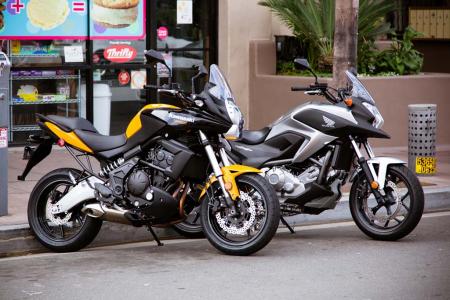Middleweight Multi-tool Shootout: 2012 Honda NC700X Vs. Kawasaki Versys - Video - Motorcycle.com
“New Concept” forms the acronym for Honda’s NC700 platform, powered by a sub-700cc parallel-Twin engine. This somewhat bold proclamation implies that other OEMs haven’t been quite as innovative.
We mostly bought in to Honda’s creative line of thought. That is until we realized that Kawasaki has had the 649cc parallel-Twin-engined Versys in its lineup since its 2006 European launch, eventually arriving on our shores in 2008. The Versys (VERsatility SYStem) was updated in 2010 with cosmetic upgrades, an adjustable windshield and vibration-reduction efforts you can read about here.
So, does Honda’s New Concept stand up in the face of an established and well-reviewed player like Kawasaki’s utility scoot? Is the Versys worth a $900 premium? Let’s find out.
Same But Different
Despite a design that is more than six years old, the Versys has a lot in common with the NC700X. Front and rear tire sizes (120/70-17, 160/60-17) are identical, and their weights are within 20 pounds of each other. Suspension travel hovers at or just below 6 inches, and seat heights vary by less than a half inch.
It’s in the engine bay where this Japanese duo differs most. Honda’s New Concept strategy is based largely on the fresh lay-down cylinder design that opens up a capacious cargo hold where the fuel tank normally would sit, expanding the bike’s usefulness in commuter or touring roles. The engine also stands out for its undersquare arrangement in which its stroke (80.0mm) is larger than its bore (73.0mm), the inverse of most motorcycle mills aside from some cruisers. This contrasts greatly with the Kawi’s oversquare (83.0 x 60.0mm) bore/stroke ratio.
The NC’s undersquare design benefits several areas, including keeping the engine narrow. But improved fuel economy is the biggest advantage. Efficiency is lost by an engine’s internal friction, which is affected by piston circumference and spinning up at higher speeds. The NC’s relatively narrow pistons offer a lower resistance, and the low-revving undersquare layout has a rev ceiling of just 6500 rpm. Conversely, the Versys redlines at a comparatively stratospheric 10,500 rpm.
The low-revving character of the Honda’s engine is unlike any other mid-displacement parallel-Twin. Compared to most moto mills, this one feels like a diesel. Ample torque is cranked out at surprisingly low revs, giving a rider constantly accessible power. But, ridden like a regular motorcycle, you’ll probably bump into its rev limiter a few times before acclimating. I found it the first time I merged onto a freeway.
The NC’s low rev ceiling has a side benefit of minimizing a parallel-Twin’s inherent vibration. After all, it’s at the midpoint of its rev range at only 3000 rpm. Cruising at 5000 rpm is no big deal for most moto engines, but that’s just 1500 revs from max on the NC. Still, it’s clearly the smoother engine.
“The Versys lets you know you’re on the hot rod of the two by raising the vibration level up a bit,” comments guest tester Martin Firestone. “Not in a bad way, just a bit buzzier feeling.”
The Kawi’s motor responds as you’d like expect from a motorcycle such as this. Although retuned for more torque and lower revs than the Ninja 650 powerplant it’s based on, it has a considerably revvier nature than the Honda.
The Versys’ maximum torque of 39.4 ft-lb arrives at 7200 rpm, 2500 rpm past the NC’s peak of 43.7 ft-lb and, indeed, higher than even the NC’s rev ceiling. The horsepower battle goes to the Versys because its engine revs higher. It’s churning out 56.5 hp at a fairly low 8250 rpm, while the Honda’s 47.7 horses are attained at just 6400 rpm.
“Although different in tune and power delivery, both engines run awesome,” Firestone observes. “The laid-down engine of the Honda is better suited for commuting and freeway use with its super-smooth and less revvy engine and awesome MPG.”
Indeed, the Honda proved to be a frugal fuel sipper. It consumed just over a gallon of gas during one light-wristed 90-mile stint, equating to a remarkable 78 mpg. And it achieves mpg in the high-40s even when mercilessly flogged. The Versys delivers good mileage, but don’t expect much more than 55 mpg even when riding conservative. Mid-40s are more likely. However, the Versys can carry 1.3 gallons more fuel than the 3.7-gallon cell underneath the NC’s seat.
Considering the Honda’s tuned-for-torque strategy and its slightly larger displacement, it came as a surprise when it got dusted by the Versys during roll-on contests at highway speeds in both 5th and 6th gears. This proves the Versys has enough torque to pull slightly taller gearing, so a sport-touring rider logging many highway miles could switch to a rear sprocket with a tooth or two fewer to tone down vibrations that aren’t killed by the rubber engine mounts and rubber footpeg inserts added in the bike’s 2010 upgrades.
The 700X’s engine excels in the commuter role, with an ultra-smooth and ever-ready powerband aided by a cooperative clutch that ensures quick getaways and easy low-speed running. The low-centered weight from the lay-down engine design delivers amazing low-speed balance. Its 6-speed transmission is practically flawless, being both buttery and precise, and it shifts gears easier than the notchier tranny in the Versys. A heavier-than-necessary throttle spring is a small nit to pick on the NC.
The Versys also outshines “normal” motorcycles in urban use, delivering good punch via fairly short gearing that works well on the street. “It has spunky low-end power that’s good around town,” observes MO’s Content Editor, Tom Roderick, adding that its engine feels much busier than the NC’s.
More by Kevin Duke
































Comments
Join the conversation